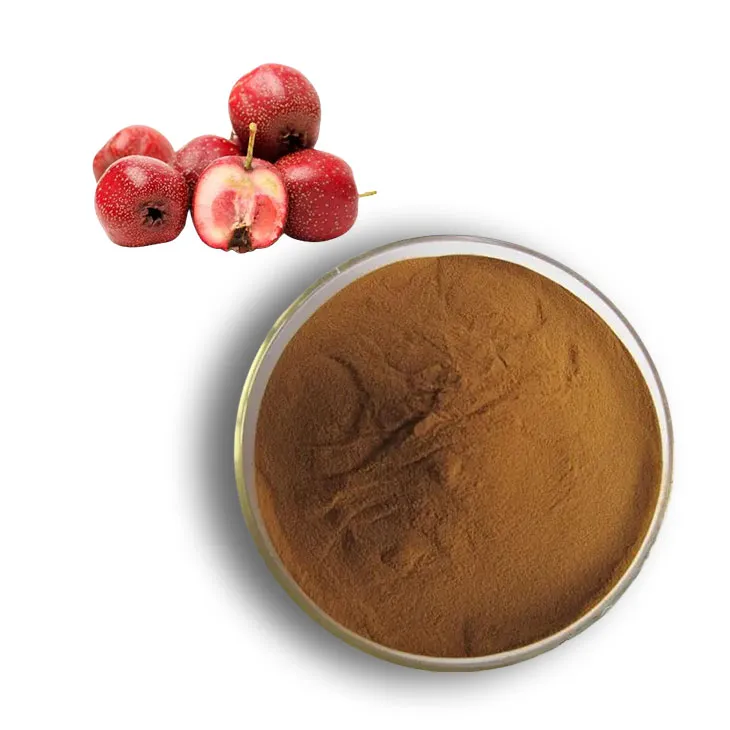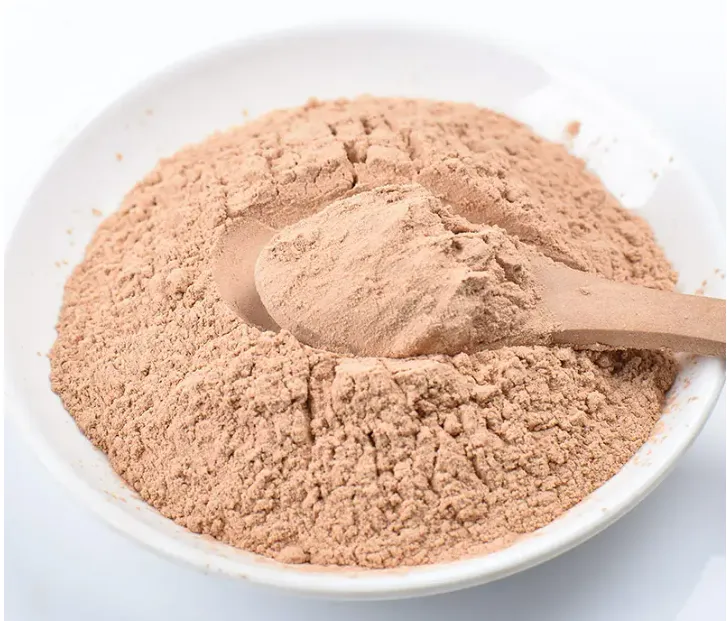- 0086-571-85302990
- sales@greenskybio.com
Supercritical Carbon Dioxide Extraction of Hawthorn Extracts
2024-11-26

1. Introduction
Hawthorn has been recognized for its numerous health - promoting properties for centuries. It is a rich source of bioactive compounds, such as flavonoids, phenolic acids, and procyanidins. These components have potential applications in the fields of medicine, food, and cosmetics. Supercritical carbon dioxide extraction has emerged as a promising technique for obtaining high - quality Hawthorn Extracts. This method offers several advantages over traditional extraction methods, including better selectivity, higher extraction efficiency, and the production of extracts with a purer profile.

2. Properties of Hawthorn
Hawthorn (Crataegus spp.) is a genus of plants that includes numerous species. The fruits of hawthorn are particularly rich in valuable substances. Flavonoids, for example, are known for their antioxidant properties. They can scavenge free radicals and protect cells from oxidative damage. Phenolic acids also contribute to the antioxidant activity of hawthorn. Moreover, procyanidins have been studied for their potential effects on cardiovascular health, such as reducing blood pressure and improving blood lipid profiles.

3. Supercritical Carbon Dioxide: An Ideal Extraction Medium
Supercritical carbon dioxide has unique physical and chemical properties that make it an excellent choice for extracting Hawthorn Extracts. At supercritical conditions (above its critical temperature of 31.1°C and critical pressure of 7.38 MPa), carbon dioxide exhibits properties between those of a gas and a liquid. It has a low viscosity, similar to a gas, which allows for easy penetration into the hawthorn matrix. At the same time, it has a relatively high density, like a liquid, enabling it to dissolve a wide range of compounds.
3.1 Solubility of Hawthorn Components in Supercritical Carbon Dioxide
The solubility of hawthorn components in supercritical carbon dioxide can be adjusted by varying the extraction conditions. Factors such as temperature, pressure, and the addition of co - solvents can influence the solubility. For example, increasing the pressure generally increases the solubility of polar compounds in supercritical carbon dioxide. Some of the more polar components in hawthorn, such as phenolic acids, may require the addition of a co - solvent, like ethanol, to enhance their solubility.
3.2 Selectivity of Supercritical Carbon Dioxide Extraction
One of the major advantages of supercritical carbon dioxide extraction is its selectivity. By carefully controlling the extraction parameters, it is possible to selectively extract certain components from hawthorn while leaving others behind. This is particularly important when targeting specific bioactive compounds for different applications. For instance, if the goal is to produce an extract rich in flavonoids for use in a nutraceutical product, the extraction conditions can be optimized to preferentially extract flavonoids over other components.

4. Comparison with Conventional Extraction Techniques
Conventional extraction techniques such as solvent extraction using organic solvents (e.g., ethanol, methanol) and steam distillation have been widely used for extracting Hawthorn Extracts. However, these methods have some limitations.
4.1 Solvent Extraction
Solvent extraction often requires large amounts of organic solvents, which can be expensive and pose environmental and safety concerns. Residual solvents in the final extract may also affect the quality and safety of the product. In addition, the extraction process may be less selective, resulting in a more complex extract with a higher proportion of unwanted components.
4.2 Steam Distillation
Steam distillation is mainly suitable for extracting volatile components from hawthorn. However, it is not very effective for extracting non - volatile bioactive compounds, such as flavonoids and phenolic acids. Moreover, the high - temperature steam used in the process may cause thermal degradation of some thermally sensitive components in hawthorn.
4.3 Advantages of Supercritical Carbon Dioxide Extraction
In contrast, supercritical carbon dioxide extraction operates at relatively low temperatures (usually below 50°C), which helps to preserve the thermally sensitive compounds in hawthorn. It also has a high selectivity, as mentioned earlier, and can produce extracts with a relatively pure profile. Additionally, carbon dioxide is a non - toxic, non - flammable, and inexpensive gas, which makes it an environmentally friendly and cost - effective extraction medium.
5. The Extraction Process
The supercritical carbon dioxide extraction of hawthorn extracts typically involves several steps.
5.1 Sample Preparation
The hawthorn fruits are first dried and ground into a fine powder. This increases the surface area available for extraction and ensures more efficient extraction.
5.2 Loading into the Extraction Vessel
The powdered hawthorn sample is then loaded into the extraction vessel. The vessel is designed to withstand the high pressures required for supercritical carbon dioxide extraction.
5.3 Setting the Extraction Parameters
The extraction parameters, such as temperature, pressure, and flow rate of carbon dioxide, are set according to the desired components to be extracted. For example, if the aim is to extract flavonoids, a specific combination of temperature and pressure may be used. The flow rate of carbon dioxide also affects the extraction efficiency, with a higher flow rate generally resulting in faster extraction but potentially lower selectivity.
5.4 Extraction
Supercritical carbon dioxide is then pumped into the extraction vessel. As it passes through the Hawthorn powder, it dissolves the target components. The extract - laden carbon dioxide is then passed through a separator, where the pressure is reduced, causing the carbon dioxide to return to its gaseous state and the dissolved components to be collected as the extract.
5.5 Post - extraction Treatment
The collected hawthorn extract may undergo further purification or concentration steps, depending on its intended use. For example, if it is to be used in a high - quality nutraceutical product, it may be further purified to remove any remaining impurities.
6. Reproducibility and Quality Control
Reproducibility is a crucial aspect of supercritical carbon dioxide extraction of hawthorn extracts. Since the extraction process is highly reproducible, it is possible to ensure consistent quality of the extract. This is achieved through strict control of the extraction parameters, such as temperature, pressure, and extraction time.
6.1 Quality Control Parameters
Quality control of the hawthorn extract involves several parameters. The content of bioactive compounds, such as flavonoids and phenolic acids, can be determined using analytical techniques like high - performance liquid chromatography (HPLC). The purity of the extract, free from contaminants such as heavy metals and pesticides, is also an important quality control measure. Additionally, the physical properties of the extract, such as its solubility and stability, need to be monitored.
6.2 Standardization of the Extraction Process
To ensure reproducibility, the extraction process can be standardized. This includes using standardized equipment, following a set protocol for sample preparation and extraction, and regularly calibrating the instruments used in the process. By standardizing the extraction process, it is possible to produce hawthorn extracts with consistent quality, which is essential for both industrial production and research purposes.
7. Applications of Hawthorn Extracts
The hawthorn extracts obtained by supercritical carbon dioxide extraction have a wide range of applications.
7.1 Nutraceutical Products
In the field of nutraceuticals, hawthorn extracts are used for their potential benefits on cardiovascular health. The flavonoids and procyanidins in hawthorn extracts may help to improve heart function, reduce blood pressure, and regulate blood lipid levels. They can be formulated into dietary supplements, such as capsules or tablets, for consumers who are interested in maintaining their cardiovascular health.
7.2 Food Industry
In the food industry, hawthorn extracts can be used as natural preservatives. Their antioxidant properties can help to prevent the oxidation of food products, thereby extending their shelf life. Hawthorn extracts can also be used as flavorings, adding a unique fruity flavor to food and beverages.
7.3 Cosmetics
The antioxidant and anti - inflammatory properties of hawthorn extracts make them suitable for use in cosmetics. They can be incorporated into skincare products, such as creams and lotions, to protect the skin from oxidative damage and reduce inflammation. Hawthorn extracts may also have potential applications in haircare products, such as shampoos and conditioners, for promoting healthy hair growth.
8. Conclusion
Supercritical carbon dioxide extraction of hawthorn extracts is a highly effective and versatile technique. It offers numerous advantages over traditional extraction methods, including better preservation of thermally sensitive compounds, high selectivity, and reproducibility. The resulting hawthorn extracts have a wide range of applications in the fields of nutraceuticals, food, and cosmetics. As research continues to explore the potential of hawthorn and its extracts, supercritical carbon dioxide extraction is likely to play an increasingly important role in the production of high - quality hawthorn - based products.
FAQ:
What are the advantages of using supercritical carbon dioxide to extract hawthorn extract?
There are several advantages. Firstly, it can operate at relatively low temperatures, which is beneficial for preserving the thermally sensitive compounds in hawthorn. Secondly, the extraction process is highly reproducible, ensuring consistent quality of the hawthorn extract. Also, the extraction parameters can be adjusted according to the desired components, enabling the production of customized hawthorn extracts for different applications.
What kind of valuable constituents are there in hawthorn?
Hawthorn is rich in various valuable constituents, such as those that are beneficial for cardiovascular health. These constituents have attracted significant attention in industries like nutraceuticals and food.
How can supercritical carbon dioxide extraction ensure the quality of hawthorn extract?
The high reproducibility of the supercritical carbon dioxide extraction process ensures consistent quality. By being able to control the extraction parameters precisely, the desired components can be extracted effectively and consistently, resulting in a high - quality hawthorn extract.
What are the potential end - uses of hawthorn extract obtained by supercritical carbon dioxide extraction?
One potential end - use is in the development of nutraceutical products for cardiovascular health. Another is as a natural preservative in the food industry. It can also be used in other applications where the unique properties of hawthorn extract are required.
How does supercritical carbon dioxide extraction compare with conventional extraction techniques for hawthorn?
Compared to conventional extraction techniques, supercritical carbon dioxide extraction can operate at lower temperatures. This is important as it helps to protect the thermally sensitive compounds in hawthorn, which may be damaged in the higher - temperature processes of conventional techniques.
Related literature
- Supercritical Fluid Extraction of Bioactive Compounds from Hawthorn: Process Optimization and Quality Evaluation"
- "Advances in Supercritical Carbon Dioxide Extraction of Hawthorn for Nutraceutical Applications"
- ▶ Hesperidin
- ▶ citrus bioflavonoids
- ▶ plant extract
- ▶ lycopene
- ▶ Diosmin
- ▶ Grape seed extract
- ▶ Sea buckthorn Juice Powder
- ▶ Beetroot powder
- ▶ Hops Extract
- ▶ Artichoke Extract
- ▶ Reishi mushroom extract
- ▶ Astaxanthin
- ▶ Green Tea Extract
- ▶ Curcumin Extract
- ▶ Horse Chestnut Extract
- ▶ Other Problems
- ▶ Boswellia Serrata Extract
- ▶ Resveratrol Extract
- ▶ Marigold Extract
- ▶ Grape Leaf Extract
- ▶ blog3
- ▶ blog4
-
Pineapple protease manufacturers from China.
2024-11-26
-
100% Pure Organic Ganoderma Lucidum Extract.
2024-11-26
-
White Peony Extract
2024-11-26
-
Cranberry Extract
2024-11-26
-
Yohimbine Bark Extract
2024-11-26
-
Thunder God Vine Extract
2024-11-26
-
Saffron Extract Powder
2024-11-26
-
White Willow Bark Extract
2024-11-26
-
Nutmeg Extract
2024-11-26
-
Lily extract
2024-11-26
-
Angelica sinensis extract
2024-11-26
-
Red Wine Extract
2024-11-26





















